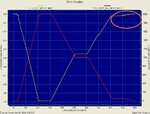sabahking86
Newbie level 3
I was writing the ATE test program at ETS364 for device VNQ5E050MK-E in my company. In one test known as k-factor i found some oscillation in the waveform. This test is perform such that we ramp the current from drain to source, and current sense will monitor the current at output. The formula is that kfactor =Iout / Isense. However, for this test during i perform at high current (k1 and K2) it is ok, the oscillation is only happening on K0 (low current). Refer the image.
My question is that
a) at what scenario of the weakness of hardware can cause this type of oscillation at low current but not high current.
b) any method in eliminate the oscillation?
My question is that
a) at what scenario of the weakness of hardware can cause this type of oscillation at low current but not high current.
b) any method in eliminate the oscillation?

